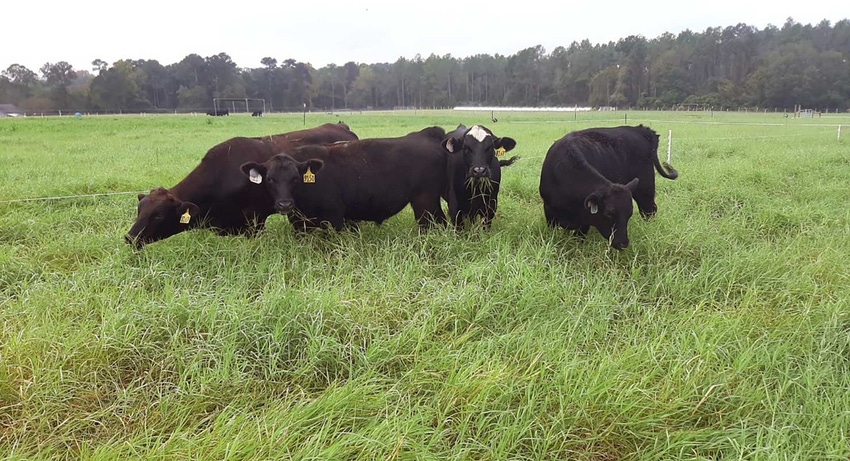December 16, 2021

Alfalfa, once a dominant forage in Georgia, is the third-highest crop for economic returns in the United States. Combined with cheap nitrogen prices, difficulty growing the desirable forage crop in Georgia’s challenging climate led to a decline in alfalfa production in the state after its peak in the 1960s.
Now University of Georgia grazing specialist Jennifer Tucker is doing her part to restore alfalfa production to the state for the benefit of both producers and the land.
Tucker, an associate professor in the Department of Animal and Dairy Science in the College of Agricultural and Environmental Sciences, is working with colleagues from Auburn University, University of Florida and the University of Tennessee on grants from the U.S. Department of Agriculture’s National Institute of Food and Agriculture (USDA NIFA) Alfalfa Seed and Alfalfa Forage System Program (ASAFS) to develop best management practices to restore grasslands and sustainably increase alfalfa production in the Southeast.
“There are many positive benefits for increased alfalfa production, but they're all very much linked to improved land and animal performance and sustainability of grazing systems,” said Tucker, who runs the Better Grazing Program on the UGA Tifton campus. “We are looking to improve alfalfa establishment in perennial grasses and the varied uses of alfalfa grass systems either for harvest as baleage or for grazing.”
Growing alfalfa
In Georgia’s humid environment, weed control, as well as disease and insect pressure, caused producers to move away from using alfalfa, but longtime UGA plant breeder Joe Bouton spent years developing alfalfa varieties that grow well in the region, Tucker said. “Currently all of the evaluations in Georgia are using alfalfa varieties developed by Dr. Bouton that were bred specifically for disease and insect resistance, as well as the heat and environment in Georgia, increasing alfalfa’s adaptation and ability to survive tough growing conditions.”
In recent years, Tucker’s program has been awarded multiple USDA-NIFA Alfalfa Forage and Research Program grants focused on increasing the use of alfalfa in the region. The most recent awards will culminate in a five-year project that will measure how much carbon is being sequestered in these alfalfa systems, as well as how it influences nutrient cycling in the soil and in the grazing animals.
“In addition to the animal and stand performance aspects, we will be looking at the nutrient cycling effects that are occurring with these projects,” Tucker said. “We have soil samples from before alfalfa establishment, and we will take more at study conclusion. This will allow us to do more in-depth analysis and illustrate what happens to the soil when you cover the land with a perennial forage mixture, especially one with a deep taproot like alfalfa.”
Alfalfa is used as a feed source for dairy and beef cattle and can reduce the need for costly nutritional supplements when cattle are primarily feed other types of diets, Tucker said.
“Our work is focused on increasing alfalfa utilization in Georgia and across the Southeast to restore grasslands while adding a profit point into pastures or hay fields, land our producers are already investing in, to provide alfalfa as a high-quality feed source,” she added.
Tucker has worked with many producers in Georgia to incorporate alfalfa into Bermuda grass forage systems, but this research will provide more concrete data to guide producers in establishing and managing alfalfa grasslands.
“In our environment we can use alfalfa-Bermuda grass mixtures from late winter through early spring (February or March) then into November, and there aren’t any other forages that really fit into that window like this particular mixture,” she said.
Using alfalfa as a carbon sink
Beginning in late September, Tucker’s team began working on a university-industry collaboration with Forage Genetics International to introduce alfalfa into research fields at the UGA-Tifton Animal and Dairy Science farm that have been used in field crop production for almost two decades to determine how alfalfa production can improve soil health and carbon sequestration.
“We’re taking this land out of annual crop production for livestock feed and putting it into a short-term perennial forage crop for livestock feed — that’s the advantage of the alfalfa crop, you're going to have it for five to seven years in this area with no soil disturbance,” Tucker said.
Her collaborative team includes UGA faculty focusing on forages, weeds, soils and precision agriculture working together to illustrate the carbon change when moving from an annual to a perennial forage crop to allow the ground to rest. The field will undergo grid sampling each year to determine what factors are changing in the soil environment and what recommendations need to be made for the health of the system.
“We know forages are great for carbon sequestration, but now we want to draw that picture more clearly. Especially with the carbon emission discussions that are going on and the carbon credits movement, we don't have any way to actually quantify a lot of this information,” Tucker said. “We see a lot of people who are in animal livestock forage areas, and that's where you're seeing your greatest carbon effects in the ground — because they're not reserving those areas just for crops. They’re utilizing that animal for the benefit of the system. The industry is very interested in seeing the results of this.”
You May Also Like




